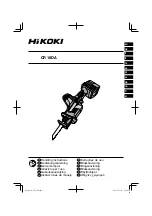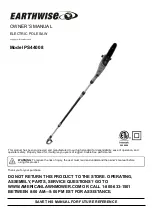
15
INSIDE CUTTINg
Inside cutting takes place when the blade is threaded through a hole in the workpiece. With your scroll saw, you can
perform this operation quickly and easily as follows:
Loosen lock handle (A) Fig. 21, and raise the holddown (B). Release blade tension by moving the blade tension lever (C)
to the horizontal position as previously explained. Release upper blade holder lever (D) as previously explained. This will
release the blade (E) and allow you to thread the blade through the next hole in the pattern. Replace blade in upper blade
holder and move blade tension lever to the vertical position to reapply blade tension. Lower holddown and you are ready
to make the next cut.
TROUBLESHOOTINg
For assistance with your machine, visit our website at www.deltamachinery.com for a list of service centers or call the
DELTA Machinery help line at 1-800-223-7278 (In Canada call 1-800-463-3582).
CHOICE OF BLADE AND SPEED
Your scroll saw will accept a wide variety of 5" flat end blades and can be operated at any speed from 600 to 1650
cutting strokes per minute. Consider the following as a general guideline for selecting a blade and operating speed.
1. Use a finer blade for cutting thin workpieces, for hard materials, or when a smooth cut is required.
2. Use a coarser blade for cutting thick workpieces, when making straight cuts or for medium to soft materials.
3. Use a blade that will have 2 teeth in the workpiece at all times.
4. Most blade packaging is marked with the size of the wood the blade is intended to cut and the minimum radius
which can be cut with that blade.
5. Slower speeds are generally more effective than faster speeds when using thin blades and making intricate cuts.
6. Always start at a slow speed and gradually increase the speed until the best cutting speed is obtained.
BLADE BREAkAgE
Blade breakage is usually caused by one or more of the following:
1. Bending the blade during installation.
2. Improper blade tension.
3. Improper blade selection for the work being cut.
4. Forcing the work into the blade too rapidly.
5. Cutting too sharp a turn for the blade being used.
6. Improper blade speed.
MAINTENANCE
kEEP MACHINE CLEAN
Periodically blow out all air passages with dry compressed air. All plastic parts should be cleaned with a soft damp
cloth. NEVER use solvents to clean plastic parts. They could possibly dissolve or otherwise damage the material.
Wear certified safety equipment for eye, hearing and respiratory protection while using compressed air.
FAILURE TO START
Should your machine fail to start, check to make sure the prongs on the cord plug are making good contact in the
outlet. Also, check for blown fuses or open circuit breakers in the line.
LUBRICATION & RUST PROTECTION
Apply household floor paste wax to the machine table, extension table or other work surface weekly. Or use a commercially
available protective product designed for this purpose. Follow the manufacturer’s instructions for use and safety.
To clean cast iron tables of rust, you will need the following materials: a sheet of medium Scotch-Brite™ Blending Hand
Pad, a can of WD-40® and a can of degreaser. Apply the WD-40 and polish the table surface with the Scotch-Brite pad.
Degrease the table, then apply the protective product as described above.
















































